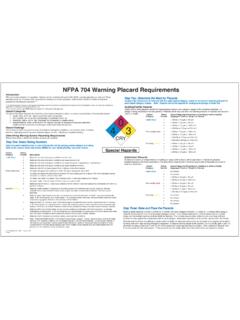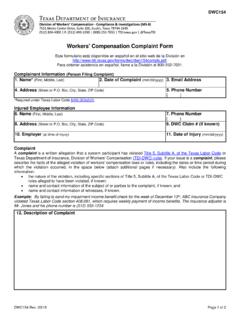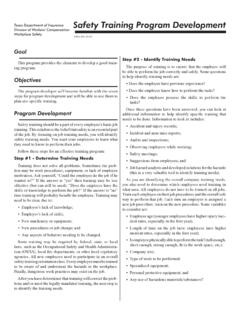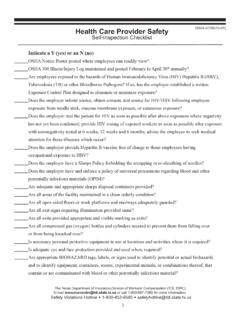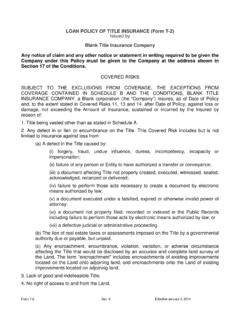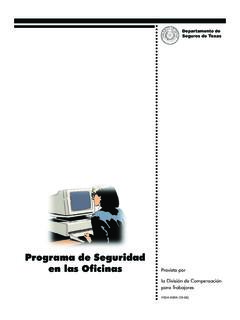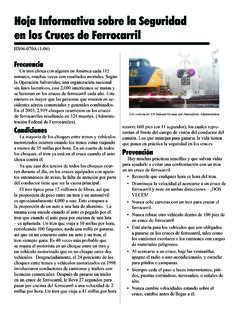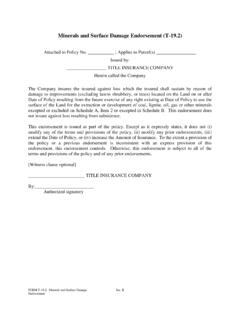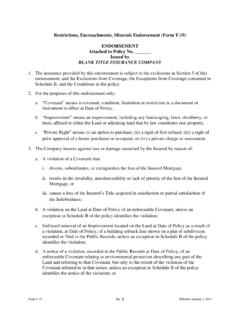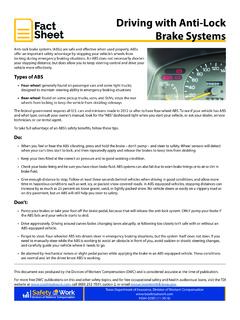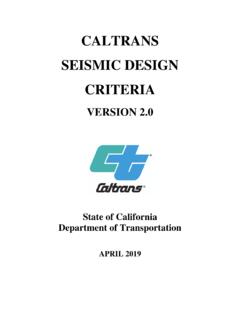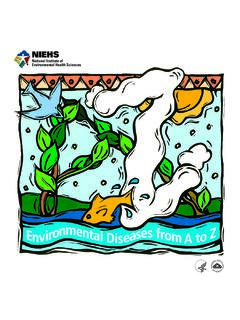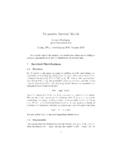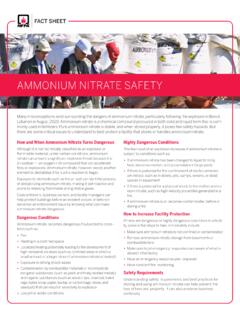Transcription of NFPA 704 Warning Placard Requirements
1 NFPA 704 Warning Placard RequirementsIntroductionWhenever large amounts of hazardous materials are being stored and used within SLAC, Warning placards are required. These placards act as an immediate Warning system for emergency service personnel, helping them identify the kinds of materials present and the dangers they pose1, Placard design is based on the hazard identification system described in Recommended System for the Identification of the Fire hazards of Materials, National Fire Protection Association (NFPA) 704. 2 For more information, see ES&H Manual, Chapter 37, "Emergency Management.
2 "Hazard CategoriesThe diamond-shaped placards use these four color-coded categories to give at a glance a general idea of the hazards present: Health: blue, at the left. Injury hazard from burning materials Flammability: red, at the top. Susceptibility of materials to burning Reactivity: yellow, at the right. Susceptibility of materials to release energy Special hazards : white, at the bottom for hazards important to emergency response personnel; additional special hazards in rectangular white boxes below the Placard Hazard RankingsThe numbers in each box give the order of severity in emergency conditions such as spills, leaks, and fires, from four, indicating severe hazard or extreme danger, to zero, indicating no required Warning System Placarding RequirementsFollow these steps to determine whether placards are One: Select Rating NumbersDetermine each material stored or used at the facility and its Warning system category and rating.
3 Refer to the material safety data sheets (MSDS) for your building/facility. Use these criteria:Subdivision Placards Subdivisions (rooms or compartments) of buildings or areas within a facility will be placarded to indicate the greatest possible hazards within those subdivisions. Placards will be required when the following amounts of materials are stored or used in a subdivision: Building facility placards must be 15 inches by 15 inches, with each category diamond inches by inches. Each category diamond on the Placard must have the proper background color.
4 The numbers must be inches in height with a stroke, and the number must be centered within its diamond. The numbers may be either white or black, providing sufficient contrast is made against the background color in each category. Subdivision placards may be smaller, typically x shall be affixed to buildings or areas within the facility on each side where entry can be made at an appropriate height to be easily seen from approaching emergency equipment. A Placard must be placed at the property line on a facility gate or post if a placarded building or area within a facility cannot be easily seen when approaching the property.
5 Affix subdivision placards next to access points into the subdivisions. These placards must be visible when doors into subdivisions are opened or closed. Hazard Rating Category Number DescriptionHealth (Blue) 4 Materials that under emergency conditions can be lethal 3 Materials that under emergency conditions can cause serious injury 2 Materials that under emergency conditions can cause temporary incapacitation or residual injury 1 Materials that under emergency conditions can cause significant irritation 0 Materials that offer no hazard beyond that of ordinary cumbustible materialFlammability (Red)
6 4 All liquids and gases with a flash point below 73F and a boiling point below 100F 3 All liquids and gases with flash points at or below 73F and a boiling point at or above 100F and those liquids having flash point at or above 73F and below 100F 2 All liquids with a flash at or above 100F and below 200F or solids that readily give off vapors 1 All liquids, solids, and semi solids with flash points at or above 200F 0 Materials that will not burn, including any material that will not burn in air when exposed to a temperature of 1500 for a period of 5 minutesReactivity (Yellow) 4 Materials readily capable of detonation or explosive reaction at normal temperatures and pressures.
7 Includes materials that are very sensitive to heat, shock, or light. Examples would include explosives A & B and organic peroxides 3 Materials which when heated and under confinement are capable of detonation and which may react violently with water. A "W" should appear as a special hazard if an explosive reaction with water can be expected. Examples would include blasting agents, fireworks, and ammonium nitrate fertilizer 2 Materials which will undergo a violent chemical change at elevated temperatures and pressures but do not detonate.
8 A "W" should appear as a special hazard if contact with water may cause a violent reaction or may cause potentially explosive mixtures to be formed. Examples would include combustible metals and water reactive corrosive materials 1 Materials which are normally stable but may become unstable in combination with other materials or at elevated temperatures and pressures. A "W" should appear as a special hazard if a vigorous but not violent reaction with water may take place. Examples would include most common corrosive and oxidizing materials 0 Materials that in themselves are normally stable, even under fire conditionsSpecial hazards (White) Note: Refer to the MSDS for the NFPA symbol for each hazard category.
9 Special hazard symbols, such as W (water reactive), OXY (oxidizing material), CRY (cryogenic material), COR (corrosive material), POI (poisonous material), or the radiation Warning symbol, must be added to the white bottom section of the Placard when available information indicates that one of these special hazards exist. When multiple special hazards exist, add white panels below the Placard to list the additional special hazards that apply. Hazard Rating Amount Requiring Placarding on a Building or within a FacilityCategory Number (Aggregate Totals of Weight or Volume)Health (Blue) 4 > 100 lbs or 10 gals or 50 cu ft 3 > 100 lbs or 10 gals or 50 cu ft 2 > 500 lbs or 55 gals or 1000 cu ft 1 > 1000 lbs or 110 gals or 200 cu ftFlammability (Red) 4 > 500 lbs or 55 gals or 1000 cu ft 3 > 500 lbs or 55 gals or 1000 cu ft 2 > 1000 lbs or 110 gals or 2000 cu ft 1 > 2000 lbs or 220 gals or 4000 cu ftReactivity (Yellow)
10 4 > 100 lbs or 10 gals or 50 cu ft 3 > 100 lbs or 10 gals or 50 cu ft 2 > 500 lbs or 55 gals or 1000 cu ft 1 > 500 lbs or 55 gals or 1000 cu ft Hazard Rating Amount Requiring Placarding on a Building or within a FacilityCategory Number (Aggregate Totals of Weight or Volume)Health (Blue) 4 Any amount 3 Any amount 2 > 100 lbs or 10 gals or 50 cu ft 1 > 500 lbs or 55 gals or 1000 cu ftFlammability (Red) 4 > 100 lbs or 10 gals or 50 cu ft 3 > 100 lbs or 10 gals or 50 cu ft 2 > 500 lbs or 55 gals or 1000 cu ft 1 > 1000 lbs or 110 gals or 2000 cu ftReactivity (Yellow) 4 Any amount 3 Any amount 2 Any amount 1 Any amountStep Two: Determine the Need for PlacardsCompare the total amount of materials with the same hazard category number to the amount requiring placards for each hazard category number.
